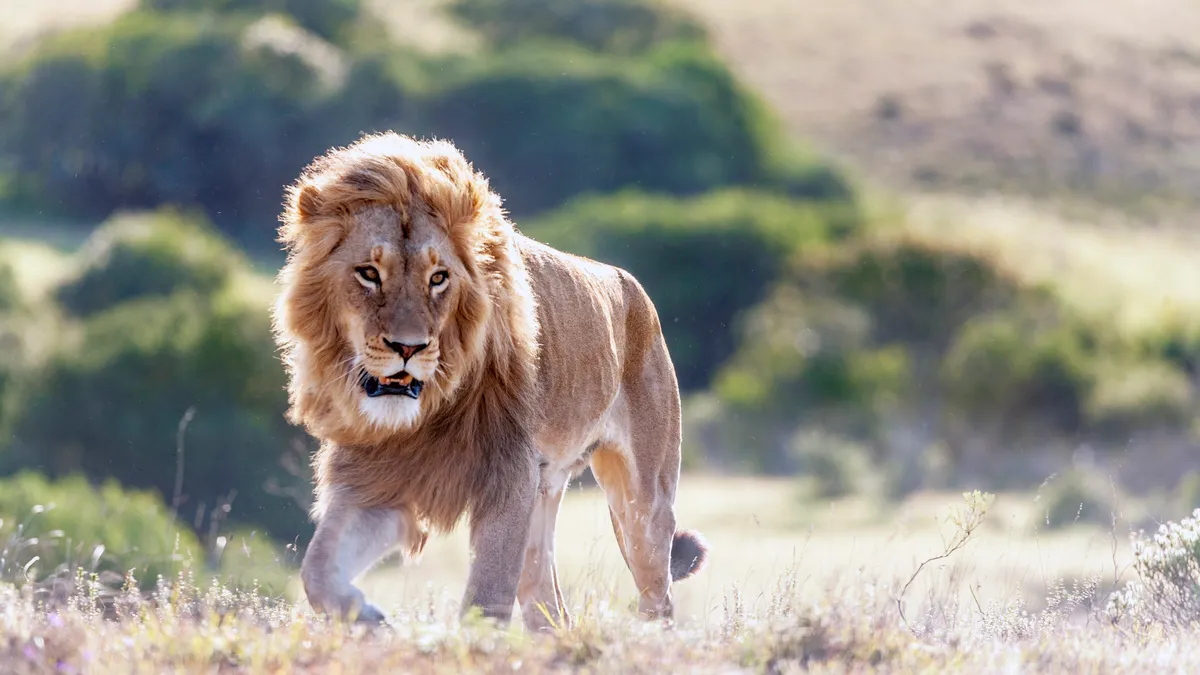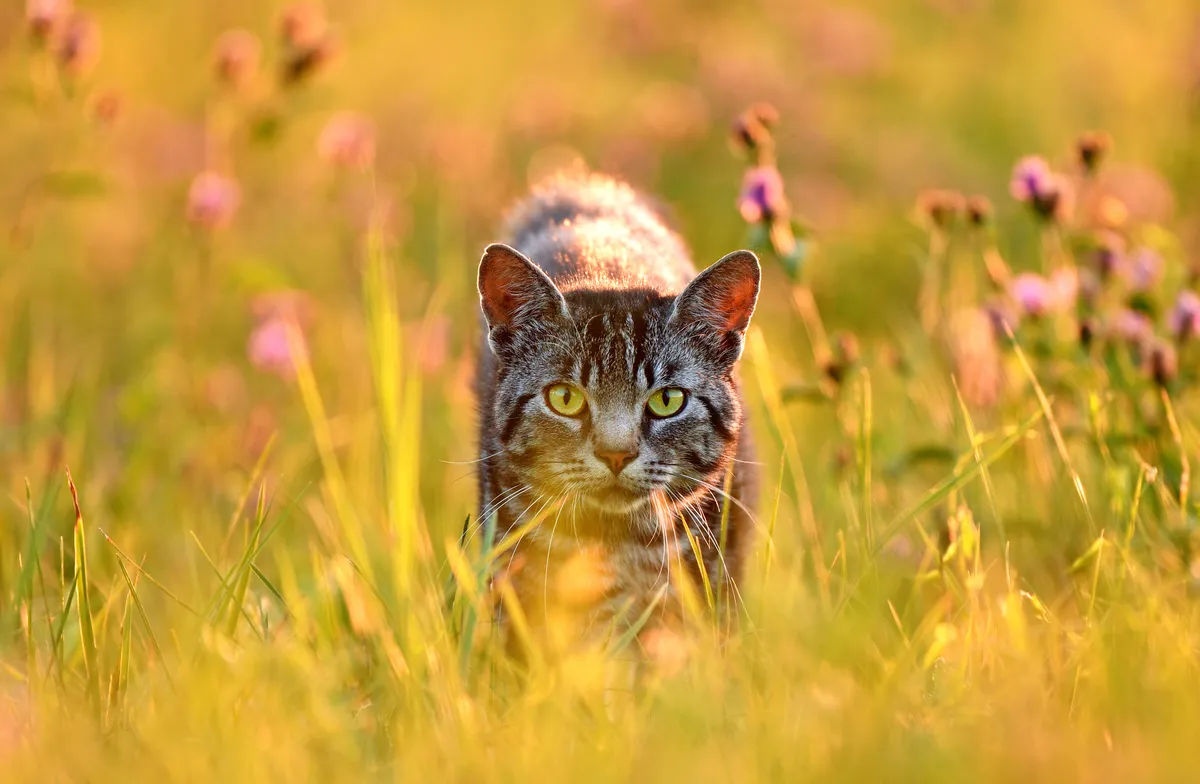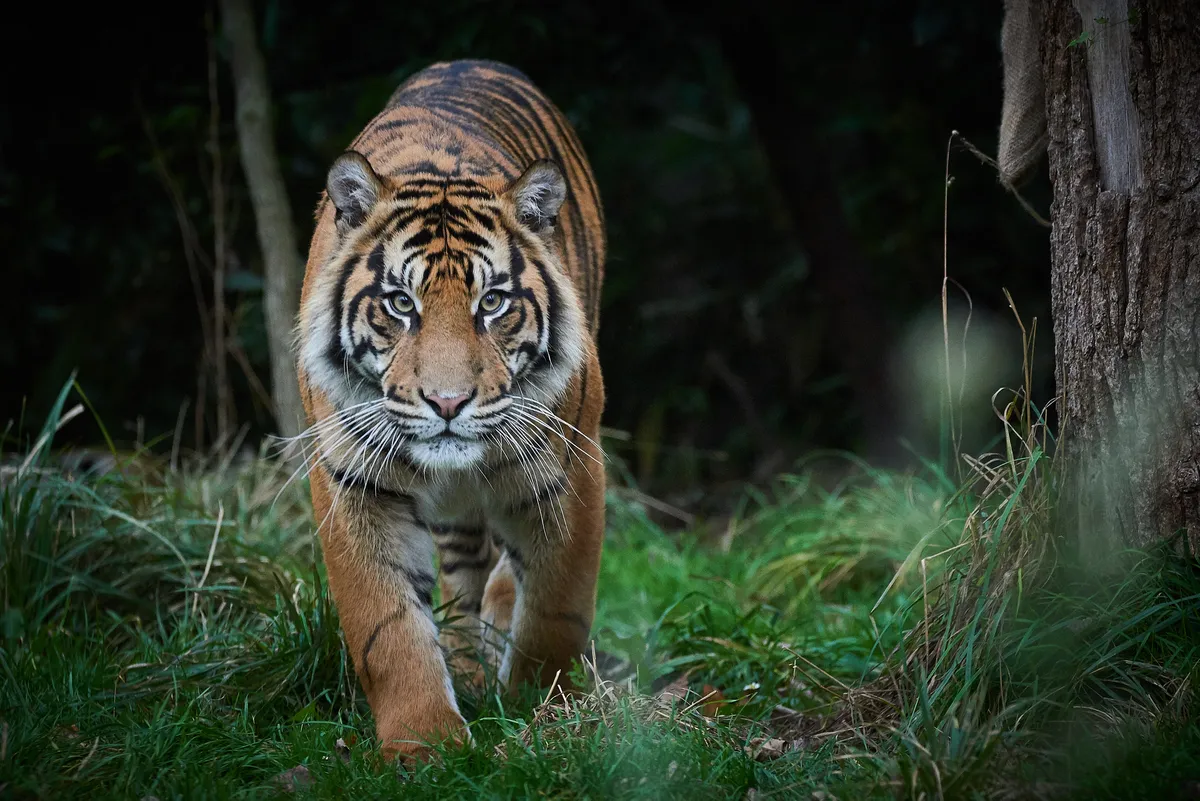A young male lion, his mane not yet fully grown, follows a dry riverbed. His attention is caught by a scent carried on the wind from a patch of scrub. Curious, he climbs the bank and buries his nose deep in the vegetation.
When he lifts his head again, his jaws are wide open and his cheeks are pulled upwards, his eyes half closed. He licks his nose repeatedly, as if tasting the air. Then, with a final sniff of the bushes, he saunters off.
To see this fascinating behaviour – usually known by its German name, flehmen – you don’t need to travel to the African savannah. You’re just as likely to spot it if you watch a pet moggy prowling the urban jungle. In fact, flehmen is performed by all 37 species in the family Felidae, from lions and other big cats to the black-footed cat, the world’s smallest wild feline (adults weigh just 1–2.45kg).
Cats carry out this ritual only when they’ve just sniffed a scent mark left by another cat. The facial contortions cause odour to be sucked up from the mouth into the sensory part of the one sense organ that cats possess but primates, like ourselves, do not – the vomeronasal, or Jacobson’s, organ.
This lies between the nostrils and the roof of the mouth, and is connected to both via ducts called the nasopalatine canals. If a cat wishes to bring its vomeronasal organ into play, it has to twist its face into a grimace.
How similar are domesticated cats and lions?

The domestic cat and the lion are similar in many other ways – indeed, the obvious discrepancy in size is the only major difference between them. Both can live in groups and raise their young co-operatively.
Both are ambush hunters, and share the same dietary peculiarities (of which more later). And they are constructed to the same body plan. The entire cat family is so alike, morphologically speaking, that, amazingly, it would take an expert to distinguish between the skinned bodies of a lion and a tiger.
So for people who don’t have the chance to see a wild lion, the humble moggy is the next best thing – a fully evolved carnivore that’s happy to sleep all day on the sofa. When your cat sits on your lap, does it knead your knee with its front paws?
If so, your pet is recalling wild behaviour that all infant felids (kittens) use to stimulate the flow of their mother’s milk. There are many more examples of shared behaviour, including scratching trees or other objects to declare ownership of a territory, playing with prey items, growling and arching the back with hackles raised to warn off rivals, rolling over to invite further contact, sleeping for extended periods during the day, and a preference for sitting in high vantage points that offer a good view.
What's the difference between wild cats and pet cats?
The key difference between wild cats and pet ones – a consequence of domestication – is the ability of the latter to form intimate social bonds with people, as well as with members of their own kind. Therefore, some of the behaviour that we see in domestic cats, such as the way in which they rub up against their owners’ legs as a tactile show of affection, and their love of being stroked, is not a part of the wild felids’ repertoire.
Why cats need to hunt - and why they can't be vegetarian

Today, cats are both adored as pets and reviled as killers of wildlife – even their owners will often admit to finding their predatory instincts upsetting. By contrast, the hunting urges of our other carnivore companions, domestic dogs, have largely been brought under our control (though it depends on a dog’s breed and training). This raises the question: why have we not, yet, achieved the same with domestic cats?
The answer lies way back, about six million years ago, when the first true cats evolved. Almost all of the cat family are locked into a hunting lifestyle by several nutritional characteristics that block their evolution away from a fully carnivorous diet. These quirks, not understood until the 1970s, include the use of protein to supply energy as well as building muscle, and an absolute requirement for several amino acids and vitamins, found only in meat or fish, that are essential for breeding successfully.
At some point quite early in the evolution of the cat family, a common ancestor of both wild and domestic cats somehow lost the ability to make several key enzymes essential for subsisting on plants. This restricted its descendants to a predatory lifestyle. (Coarse grass, eaten from time to time by many cats, including most pets with outdoor access, is not digested. It may act as a ‘scour’ to help dislodge parasites from the gut.)
Only recently have cat owners been able to feed their pets a balanced diet without the latter having to supplement it by hunting. And only recently have cats that do not know how to hunt been able to breed and raise young. Another legacy of cats’ predatory past can be seen in the way in which pet cats play with toys.
Dr Sarah Hall and I carried out research at Southampton University that showed that their favourite toys generally resemble wild prey in some way. For instance, such toys may be furry, or move in unpredictable ways. Mouse-sized toys are usually held in the front paws or teeth, whereas larger toys tend to be kept at paws’ length, as if they are as potentially hazardous as the rats that the cats seem to think they resemble.
Furthermore, adult domestic cats play more ferociously, not less, as they get hungrier – suggesting that these games are substitutes for the hunting trips that hunger would drive cats to undertake in the wild. And, though pet cats appear to become bored with toys very quickly, they will soon resume playing if the toys start to come apart. It’s almost as if they sense that a ‘kill’ is imminent.
All of this evidence points to the probability that when grown-up domestic cats are playing with toys, they think that they are actually hunting. If so, the use of prey-like toys as distractions and non-lethal rewards could potentially be a solution to the problem of how to satisfy our pets’ innate urge to hunt without blood being spilled.
My research with Sarah Hall also helps to explain why all members of the cat family are renowned for ‘torturing’ their prey, apparently taunting it before finally going for the kill. The cats are not ‘having fun’; they’re simply caught between the need to kill to eat, and the fear that whatever they are trying to catch will turn around and bite back. old habits die hard.
How wild is the domestic cat?
Like most wild cat species, domestic cats tend to be more active at night than during the day, as this pattern of activity mirrors the habits of their ancestral prey – especially rodents and other small mammals – in their original habitats such as savannah, woodland, semi-desert, mountains and scrub. Incidentally, this is why keeping your pet cat indoors after dark is likely to be one of the most effective strategies for limiting its impact on your local wildlife, particularly mammals.
(A survey of domestic cats’ hunting behaviour carried out in Reading in 2008–09 found that woodmice were their top prey item, accounting for 43 per cent of all animals brought to their owners by cats in the study.)
Domestic cats have not only retained the habits of their wild relatives, but also the super-senses that make them such formidable predators.
How well do cats see?
Their vision has several adaptations to hunting in low light, notably large eyes with retinas packed with sensitive rods, which enables them to see superbly in the half-light of dawn and dusk (albeit in black and white).
In bright daylight they see much less well than we do – and are also red/green colour-blind – but this is no hindrance for nocturnal hunters. The ears of domestic cats, meanwhile, can detect sounds far higher in pitch than those that we’re able to hear (hence we call them ultrasound). Tuning into the almost inaudible squeaks with which mice and voles communicate is thus no problem.
How well do cats hear?
The external parts of their ears – the pinnae – are independently mobile, allowing them to locate the precise sources of sounds far more accurately than we can. Our pet cats’ sense of smell is much keener than ours, as well. But though this means that Tiddles and Tinkerbell are easily able to sniff out the traces of odour left by mice, voles, rats and shrews in the undergrowth, in practice smell is less important to them than sight and sound when they are hunting.
By contrast, the olfactory prowess of domestic dogs is in a totally different league and is their primary predatory sense.
How sociable are cats?
One of the key areas of interest to researchers studying cat behaviour is sociability, and here, too, there are parallels between wild and domestic felines. Most species of cat are solitary once they have left their mother and litter mates.

Both male and female adult tigers are loners, for example. The females defend separate territories, while those of mature males are larger and include the home ranges of up to seven females. The lion is the best-known exception to this rule, being the only feline in which both sexes live together, but there are also two other sociable cat species. Male cheetahs band together in small groups up to four strong, known as coalitions, to improve their hunting success and chances of holding a territory (adult females are loners).
Similarly, female domestic cats may also form alliances, but in order to help raise each others’ kittens (in this instance, it is the adult males that are solitary). In the 1970s, David Macdonald discovered that young female farm cats often stay with their mothers until they themselves are old enough to breed; mother and daughters will then share the same nest and suckle one another’s kittens. His work was revealed in 1979 in a BBC film called The Curious Cat, part of the popular series The World About Us.
It isn’t clear whether this female bonding is to the kittens’ advantage. On the one hand, at least one of the females will be with them most of the time, so they are better protected against predators. But, on the other, if just one kitten catches a virus, the disease quickly spreads to the whole litter. How and when this habit evolved remains something of a mystery – it has never been recorded in wild species of cat. One theory is that it’s an evolutionarily recent adaptation to living close to concentrated sources of food.
Living in close proximity to other members of the same species, especially those as well armed as cats, requires clear and unambiguous signalling. Wild and domestic cats alike cement the bonds between group members by walking side by side and rubbing their cheeks together. But, uniquely in domestic cats, the raising of the tail to the vertical indicates amicable intentions. Macdonald noticed that if farm cats raise tails when approaching one another, they generally rub their cheeks or flanks, mingling scents. Or they sit and groom each other – another way to maintain colony cohesion. But if one or both cats don’t raise tails, they carefully skirt round one another – or a tussle may ensue.
All of today’s domestic cats, from moggies to pedigree Siamese, are now known to be descended from the wildcat Felis silvestris. This species’ range extends from Scotland in the extreme north-west as far as Mongolia and South Africa. Its temperament varies hugely – in Europe, wildcats are difficult to handle, even as kittens, whereas the African race, lybica, is the easiest to tame. It was almost certainly lybica that the ancient Egyptians domesticated. right place, right time.
There are about 30 other species of small cat, most with similar lifestyles to the wildcat, and many of them have been tamed. The ancient Egyptians, for example, kept jungle cats, caracals and servals as well as domesticated wildcats. But, historically, none apart from the African wildcat was fully tamed. The wildcat had the right mix of characteristics and was in the right place at the right time, thereby becoming the familiar ‘lion in your living room’.
Main image © Getty Images